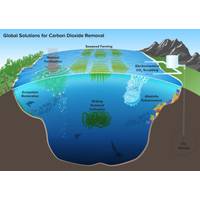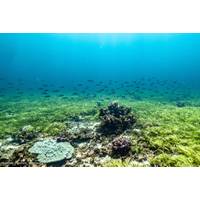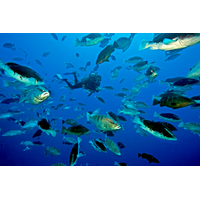
Floating Offshore Wind: New Seascape, New Challenges
on European experiences and documents. For reference, Wise cited the “White Paper on Offshore Wind Energy” written by the Netherlands’ Ministry of Infrastructure and the Environment and The Ministry of Economic Affairs in 2014.Readers may recall that in February 2022 the National Academy of Sciences released a study sponsored by BOEM that documented how wind towers degrade maritime radar. Turbines clutter a radar’s display, resulting in an ambiguous and confusing picture for the operator, according to the NAS report.Wise was asked about developments pertaining to radar-wind

Carbon Dioxide Removal (CDR) ... To Clear the Air, Look Beneath the Waves
phenomenon is ocean CDR—the field researching and developing technology to aid and expedite the ocean’s natural carbon sink processes, remove significant amounts of carbon from the atmosphere and make the 1.5°C goal more attainable.Six degrees of decarbonizationAccording to the National Academy of Sciences, Engineering and Medicine (NASEM), there are currently six main ocean CDR techniques: 1) seaweed farming to increase green space that needs CO2 to grow, 2) nutrient fertilization to enhance phytoplankton growth and uptake of CO2, 3) ecosystem restoration to move carbon dioxide through

Opinion: Let's Get the Plastic Out of Our Lives (& Waterways)
that's easy to ignore. Last year, I contributed the U.S. average-per-person 300 pounds of plastic garbage to wherever it went after convenient curbside pickup. So out of sight, out of mind, right? Not really, but does it matter? Yes, it does.In a fascinating recent report, the National Academy of Sciences, Engineering, and Medicine politely told us that we're choking ourselves to death on manufactured plastic waste and that 80% of the harmful plastic in the ocean comes from land-based sources.It's the micro-plastics, smaller than 5 mm (the size of a sesame seed) and nano-plastics
Maritime Risk Symposium: Registration is Now Open
The University of Houston’s College of Technology will host the 12th Annual Maritime Risk Symposium, a virtual event, in collaboration with the National Academy of Sciences from November 1-5, 2021.The Maritime Risk Symposium is an annual conference in which government and maritime industry leaders, port representatives, researchers, and solution providers convene to examine current and emerging threats to maritime security.RegistrationRegistration for this year’s virtual Maritime Risk Symposium has been reduced to $50 per person. Registrants will receive a personalized code to participate

"Early Bird" Registration for 2021 Maritime Risk Symposium ends soon
The University of Houston’s College of Technology will host the 12th Annual Maritime Risk Symposium (MRS 2021), in collaboration with the National Academy of Sciences, from November 2-4, 2021, at the at the University of Houston’s Student Center-South.The Maritime Risk Symposium is an annual three-day conference in which government and maritime industry leaders, port representatives, researchers, and solution providers convene to examine current and emerging threats to maritime security. Through presentations, panels, and open forums, the 2021 Maritime Risk Symposium will be organized into

Shrinking Sea Meadows Store More Carbon Than Forests. Scientists Race to Track What’s Left
been helped by recent advances in cloud computing and data storage, he said. “We are in such an exciting period.”Seagrass meadows are believed to be retreating around 7% per year globally, according to the most recent seagrass census published in a 2009 study in Proceedings of the National Academy of Sciences. It notes the estimate was based on incomplete data available at the time.The more closely studied areas illustrate the harm human activity can cause. Pollution from mining and damage by fisheries may have helped to eliminate 92% of mainland Britain’s seagrasses in over a century

Conservation for Endangered Reef Fish Yields Results
of California San Diego has documented a successful recovery effort among Nassau Grouper populations in the Cayman Islands thanks to an approach involving government agencies, academic researchers, and nonprofit organizations.The study, published January 6, 2020 in Proceedings of the National Academy of Sciences, used a two-pronged approach including tagging and video census data for monitoring and counting Nassau Grouper populations in an effort to more accurately estimate annual numbers of fish in the population and thus provide insight into the effects of ongoing conservation efforts. While

Surprising Enzymes Found in Giant Ocean Viruses
potential to cause life-threatening illnesses. Their findings, which examine newly-identified genes carried by mysterious “giant” viruses, could represent potential new drug targets for giant viruses linked to human diseases. The work published this week in Proceedings of the National Academy of Sciences.An international team of researchers team searched more than 8,000 virus genomes and found that many newly-discovered giant viruses contain multiple genes for a type of enzyme called cytochrome P450. P450 enzymes are common in animals, plants and bacteria, but finding them in new viruses

Walter Munk: 1917-2019
1993, the building was officially named the “Judith and Walter Munk Laboratory.” (Photo Credit: UC San Diego/ Scripps Institution of Oceanography)Throughout his career, Munk acquired a resume of accolades almost as impressive as the work that inspired them. Munk was elected to the National Academy of Sciences in 1956 and to the Royal Society of London in 1976. He was a Guggenheim Fellow three times.In 1983, Munk was honored with the President’s National Medal of Science, the nation’s highest award for lifetime achievement in scientific research. In 1999, Munk was awarded the Kyoto



 February 2024
February 2024





